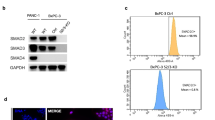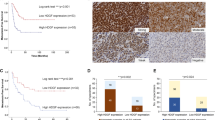Abstract
Secreted frizzled-related proteins (sFRPs) comprise a family of five secreted glycoproteins that antagonize Wnt signaling. Aberrant activation and upregulation of the Wnt pathway is a key feature of many cancers. Thus, role of sFRP as a negative regulator of Wnt signaling may have important implications in tumorigenesis, and its downregulation has been correlated with human cancers. Recently, we reported Wnt signaling and dishevelled (Dvl) overexpression in malignant pleural mesothelioma (MM). Here, we report significant transcriptional downregulation of the SFRP gene family in MM primary tissues and cell lines as well as several other cancer cell lines (breast, lung, glioma, and cervical) compared to normal cells. One or more SFRPs were downregulated in approximately 85% (18 of 21) of primary MM tumor specimens compared to normal pleural tissue. Eight of the nine cancer cell lines we examined showed silencing of the SFRP family. Methylation-specific PCR (MSP) analysis showed that SFRP1, SFRP4, and SFRP5 gene promoters are frequently methylated in MM primary tissue (>80%). Furthermore, transfection of the SFRP gene construct into MM cell lines lacking SFRP expression resulted in apoptosis and growth suppression. Our results suggest that methylation silencing of SFRPs may be one of the important mechanisms of aberrant Wnt signaling activation in MM.
This is a preview of subscription content, access via your institution
Access options
Subscribe to this journal
Receive 50 print issues and online access
$259.00 per year
only $5.18 per issue
Buy this article
- Purchase on Springer Link
- Instant access to full article PDF
Prices may be subject to local taxes which are calculated during checkout




Similar content being viewed by others
References
Abu-Jawdeh G, Comella N, Tomita Y, Brown LF, Tognazzi K, Sokol SY and Kocher O . (1999). Lab. Invest., 79, 439–447.
Abutaily AS, Collins JE and Roche WR . (2003). J. Pathol., 201, 355–362.
Bafico A, Gazit A, Pramila T, Finch PW, Yaniv A and Aaronson SA . (1999). J. Biol. Chem., 274, 16180–16187.
Baylin SB . (2002). Semin. Cancer Biol., 12, 331–337.
Butchart EG . (1999). Oncologist, 4, 488–500.
Finch PW, He X, Kelley MJ, Uren A, Schaudies RP, Popescu NC, Rudikoff S, Aaaronson SA, Varmus HE and Rubin JS . (1997). Proc. Natl. Acad. Sci. USA, 94, 6770–6775.
Fukuhara K, Masatoshi K, Masato K, Hiroaki S, Takanobu K, Kowaka C, Orii A, Fujita J and Fujii S . (2002). J. Clin. Endocrinol. Metabol., 87, 1729–1736.
Giles RH, van Es JH and Clevers H . (2003). Biochim. Biophys. Acta, 1653, 1–24.
Herman JG, Graff JR, Myohanen S, Nelkin BD and Baylin SB . (1996). Proc. Natl. Acad. Sci. USA, 93, 9821–9826.
Hu E, Zhu Y, Fredrickson T, Barnes M, Kelsell D, Beeley L and Brooks D . (1998). Biochem. Biophys. Res. Commun., 247, 287–293.
Ijiri K, Nagayoshi R, Matsushita N, Tsuruga H, Taniguchi N, Gushi A, Sakakima H, Komiya S and Matsuyama T . (2002). J. Rheumatol., 29, 2266–2270.
Jones SE and Jomary C . (2002). BioEssays, 24, 811–820.
Ko J, Ryu KS, Lee YH, Na DS, Kim YS, On YM, Kim IS and Kim JW . (2002). Exp. Cell. Res., 280, 280–287.
Lee YC, Light RW and Musk AW . (2000). Curr. Opin. Pulmonol. Med., 6, 267–274.
Lustig B and Behrens J . (2003). J. Cancer Res. Clin. Oncol., 129, 199–221.
Rattner A, Hsieh JC, Smallwood PM, Gilbert DJ, Copeland NG, Jenkins NA and Nathans J . (1997). Proc. Natl.Acad. Sci. USA, 94, 2859–2863.
Roth W, Wild-Bode C, Platten M, Grimmel C, Melkonyan HS, Dichgans J and Weller M . (2000). Oncogene, 19, 4210–4220.
Suzuki H, Gabrielson E, Chen W, Anbazhagan R, Van Engeland M, Weijenberg MP, Herman JG and Baylin SB . (2002). Nat. Genet., 31, 141–149.
Uematsu K, Kanazawa S, You L, He B, Xu Z, Li K, Peterlin BM, McCormick F and Jablons DM . (2003). Cancer Res., 63, 4547–4551.
Uren A, Reichsman F, Anest V, Taylor WG, Muraiso K, Bottaro DP, Cumberledge S and Rubin JS . (2000). J. Biol. Chem., 275, 4374–4382.
Wang S, Krinks M, Lin K, Luyten FP and Moos M . (1997). Cell, 88, 757–766.
Wong SC, Lo SF, Lee KC, Yam JW, Chan JK and Hsiao WL . (2002). J. Pathol., 196, 145–153.
Zhou Z, Wang J, Han X, Zhou J and Linder S . (1998). Int. J. Cancer, 78, 95–99.
Acknowledgements
We thank Dr Amir Rattner (Department of Molecular Biology and Genetics, Johns Hopkins University School of Medicine) for kindly providing the SFRP4 cDNA construct and Dr Hiromu Suzuki (Sidney Kimmel Comprehensive Cancer Center at Johns Hopkins) for kindly providing the primer sequences of MSP and RT-PCR for the SFRP genes. This work was supported by the Larry Hall memorial trust and the Kazan, McClain, Edises, Abrams, Fernandez, Lyons & Farrise Foundation.
Author information
Authors and Affiliations
Corresponding author
Rights and permissions
About this article
Cite this article
Lee, A., He, B., You, L. et al. Expression of the secreted frizzled-related protein gene family is downregulated in human mesothelioma. Oncogene 23, 6672–6676 (2004). https://doi.org/10.1038/sj.onc.1207881
Received:
Revised:
Accepted:
Published:
Issue Date:
DOI: https://doi.org/10.1038/sj.onc.1207881
Keywords
This article is cited by
-
High-risk HPV infection modulates the promoter hypermethylation of APC, SFRP1, and PTEN in cervical cancer patients of North India
Molecular Biology Reports (2020)
-
Delivery of expression constructs of secreted frizzled-related protein 4 and its domains by chitosan–dextran sulfate nanoparticles enhances their expression and anti-cancer effects
Molecular and Cellular Biochemistry (2018)
-
WNT signaling – lung cancer is no exception
Respiratory Research (2017)
-
Antagonizing canonical Wnt signaling pathway by recombinant human sFRP4 purified from E. coli and its implications in cancer therapy
Molecular and Cellular Biochemistry (2016)
-
Secreted frizzled-related protein promotors are hypermethylated in cutaneous squamous carcinoma compared with normal epidermis
BMC Cancer (2015)



